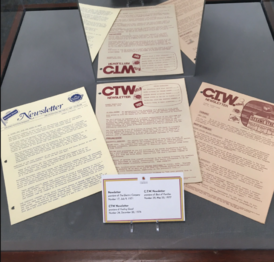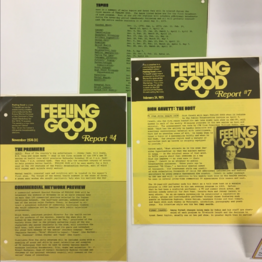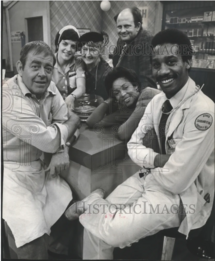Feeling Good (lost PBS TV series; 1974-1975): Difference between revisions
No edit summary |
No edit summary |
||
| (11 intermediate revisions by 3 users not shown) | |||
| Line 4: | Line 4: | ||
|status=<span style="color:red;">'''Lost'''</span> | |status=<span style="color:red;">'''Lost'''</span> | ||
}} | }} | ||
'''''Feeling Good''''' | '''''Feeling Good''''' is an American short-lived television series hosted by Dick Cavett and produced by the Children's Television Workshop (CTW, now Sesame Workshop). The series aired on PBS from November 20th<ref>[https://www.nytimes.com/1974/11/20/archives/tv-pbs-expounds-health-carein-feeling-good.html "PBS Expounds Health Care in Feeling Good"]</ref>, 1974 to 1975 with two seasons. It was the first TV series produced by the CTW that was aimed at adults instead of children, and it was also the first TV series about health. The show is considered '''lost''', with none of the episodes being publicly shown and images exist. | ||
==Plot== | ==Plot== | ||
Mass‐appeal guest stars were used each week | Mass‐appeal guest stars were used each week along with a cast of regulars that congregated in a general store called “Mac's Place”—a kind of antiseptic “Hot I Baltimore.” The first season covered such diverse matters as mental health, prenatal and nutrition<ref>[https://www.nytimes.com/1975/05/04/archives/how-tvs-feeling-good-went-bad-how-tvs-feeling-good-went-bad.html "How TV's 'Feeling Good' Went Bad"]</ref>. Through the health problems and behavior of its residents, and through songs, sketches and animation, documentary segments and tips on staying healthy were presented. | ||
==Production== | ==Production== | ||
40 years ago, the CTW officials decided to extend their efforts to the adult audience, in particular the under‐educated, and began work on a series about health. Plans called for production of 26 hour ‐ long shows. The budget was a healthy $6.5 million, making the cost per show higher than anything ever before attempted on PBS. | |||
The man in charge of the project was William Robin. executive producer and vice president of CTW. Robin and his staff worked under the assumption that most people already know the dangers of improper health care | The man in charge of the project was William Robin. executive producer and vice president of the CTW. Robin and his staff worked under the assumption that most people already know the dangers of improper health care but lack motivation to change their habits. Since it seemed clear that traditional documentary methods had failed to influence them (Robin mentions the negligible results achieved with costly anti‐smoking campaigns), the producers of “Feeling Good” wanted a new approach. | ||
The staff worked with the same “model” developed by the CTW for its children's programs. Experts were interviewed and data were gathered about the subject matter. Seminars were held throughout the country at which specific health problems were outlined along with methods of presenting the material to the TV audience. | The staff worked with the same “model” developed by the CTW for its children's programs. Experts were interviewed and data were gathered about the subject matter. Seminars were held throughout the country at which specific health problems were outlined along with methods of presenting the material to the TV audience. | ||
| Line 19: | Line 19: | ||
The series originally aired on PBS from November 20, 1974 to 1975. After the show was revamped, it later aired on Channel 13 Wednesdays at 8 P.M.—with a repeat Sundays, at 6:30 P.M. It is unknown for how long it lasted, but since it was short-lived, it likely had 26 episodes and ended on June 25, 1975. | The series originally aired on PBS from November 20, 1974 to 1975. After the show was revamped, it later aired on Channel 13 Wednesdays at 8 P.M.—with a repeat Sundays, at 6:30 P.M. It is unknown for how long it lasted, but since it was short-lived, it likely had 26 episodes and ended on June 25, 1975. | ||
None of the episodes have | None of the episodes have surfaced online and are considered lost. Unlike other shows produced by the CTW, the series never aired reruns and was never released on home video. | ||
The only | The only proof of its existence is the poster, articles of the ''New York Times'' about the series, images of the Feeling Good newsletters and press photos of the series. | ||
==Gallery== | ==Gallery== | ||
<gallery mode="packed" heights="175px"> | <gallery mode="packed" heights="175px"> | ||
Feeling Good poster.jpg|Poster of the series. | Feeling Good poster.jpg|Poster of the series. | ||
Feelinggood1.jpg|From left to right: Dick Cavett, Joseph Catano, Karen Kline and Dr. Peter Peacock conducting stress tests. | Feelinggood1.jpg|From left to right: Dick Cavett, Joseph Catano, Karen Kline and Dr. Peter Peacock conducting stress tests<ref>https://www.alamy.com/stock-photo-feeling-good-from-left-dick-cavett-joseph-catano-karen-kline-dr-peter-128561543.html</ref>. | ||
Dickcavettandjuliachild.jpg|Dick Cavett and Julia Child | Dickcavettandjuliachild.jpg|A screenshot featuring Dick Cavett and Julia Child. | ||
Dickcavettpressphoto.jpg|Dick Cavett and the logo | Dickcavettpressphoto.jpg|Dick Cavett and the show's logo. | ||
Feelinggoodnewyorktimespage.png|A page of the ''New York Times'' featuring an article about the series premiere. | Feelinggoodnewyorktimespage.png|A page of the ''New York Times'' featuring an article about the series premiere. | ||
Feelinggoodnewyorktimes.png|Another page of the ''New York Times'' featuring | Feelinggoodnewyorktimes.png|Another page of the ''New York Times'' featuring another article of the series. | ||
Feelinggoodreport.png|An image of the newsletter<ref>https://hornbakelibrary.wordpress.com/2019/12/03/the-workshop-reaches-out-the-childrens-television-workshop-papers/</ref>. | Feelinggoodreport.png|An image of the newsletter<ref>https://hornbakelibrary.wordpress.com/2019/12/03/the-workshop-reaches-out-the-childrens-television-workshop-papers/</ref>. | ||
CTWnewsletters.png|CTW newsletters featuring the logo | CTWnewsletters.png|CTW newsletters featuring the show's logo. | ||
Feelinggoodreports2.png|Another image of the newsletters. | Feelinggoodreports2.png|Another image of the newsletters. | ||
Feelinggoodjoemorton.png|Joe Morton and the cast of ''Feeling Good''. | Feelinggoodjoemorton.png|Joe Morton (right) and the cast of ''Feeling Good''. | ||
</gallery> | </gallery> | ||
==References== | |||
{{reflist}} | |||
==External Links== | ==External Links== | ||
| Line 42: | Line 45: | ||
*[https://www.imdb.com/title/tt0233053/ An IMDb page of the series.] | *[https://www.imdb.com/title/tt0233053/ An IMDb page of the series.] | ||
[[Category:Lost TV|Feeling Good]] | |||
[[Category:Completely lost media|Feeling Good]] | |||
[[Category:Lost TV]] | |||
[[Category:Completely lost media]] | |||
Latest revision as of 12:07, 19 April 2024
Feeling Good is an American short-lived television series hosted by Dick Cavett and produced by the Children's Television Workshop (CTW, now Sesame Workshop). The series aired on PBS from November 20th[1], 1974 to 1975 with two seasons. It was the first TV series produced by the CTW that was aimed at adults instead of children, and it was also the first TV series about health. The show is considered lost, with none of the episodes being publicly shown and images exist.
Plot
Mass‐appeal guest stars were used each week along with a cast of regulars that congregated in a general store called “Mac's Place”—a kind of antiseptic “Hot I Baltimore.” The first season covered such diverse matters as mental health, prenatal and nutrition[2]. Through the health problems and behavior of its residents, and through songs, sketches and animation, documentary segments and tips on staying healthy were presented.
Production
40 years ago, the CTW officials decided to extend their efforts to the adult audience, in particular the under‐educated, and began work on a series about health. Plans called for production of 26 hour ‐ long shows. The budget was a healthy $6.5 million, making the cost per show higher than anything ever before attempted on PBS.
The man in charge of the project was William Robin. executive producer and vice president of the CTW. Robin and his staff worked under the assumption that most people already know the dangers of improper health care but lack motivation to change their habits. Since it seemed clear that traditional documentary methods had failed to influence them (Robin mentions the negligible results achieved with costly anti‐smoking campaigns), the producers of “Feeling Good” wanted a new approach.
The staff worked with the same “model” developed by the CTW for its children's programs. Experts were interviewed and data were gathered about the subject matter. Seminars were held throughout the country at which specific health problems were outlined along with methods of presenting the material to the TV audience.
Availability
The series originally aired on PBS from November 20, 1974 to 1975. After the show was revamped, it later aired on Channel 13 Wednesdays at 8 P.M.—with a repeat Sundays, at 6:30 P.M. It is unknown for how long it lasted, but since it was short-lived, it likely had 26 episodes and ended on June 25, 1975.
None of the episodes have surfaced online and are considered lost. Unlike other shows produced by the CTW, the series never aired reruns and was never released on home video.
The only proof of its existence is the poster, articles of the New York Times about the series, images of the Feeling Good newsletters and press photos of the series.
Gallery
From left to right: Dick Cavett, Joseph Catano, Karen Kline and Dr. Peter Peacock conducting stress tests[3].
An image of the newsletter[4].
References
- ↑ "PBS Expounds Health Care in Feeling Good"
- ↑ "How TV's 'Feeling Good' Went Bad"
- ↑ https://www.alamy.com/stock-photo-feeling-good-from-left-dick-cavett-joseph-catano-karen-kline-dr-peter-128561543.html
- ↑ https://hornbakelibrary.wordpress.com/2019/12/03/the-workshop-reaches-out-the-childrens-television-workshop-papers/
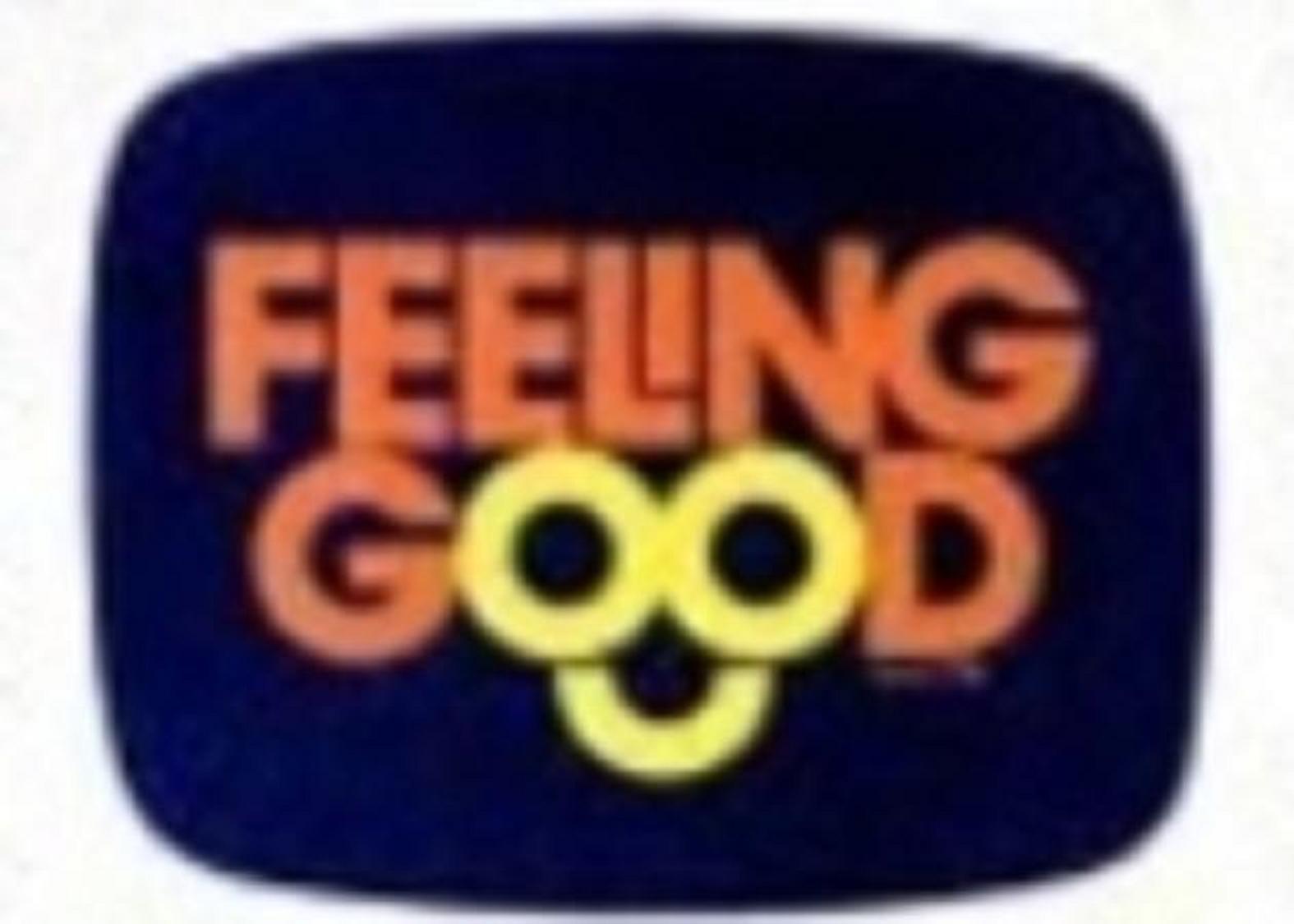

![From left to right: Dick Cavett, Joseph Catano, Karen Kline and Dr. Peter Peacock conducting stress tests[3].](/w/images/thumb/3/32/Feelinggood1.jpg/309px-Feelinggood1.jpg)

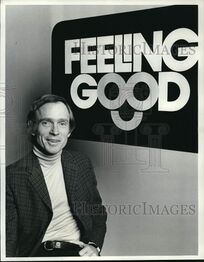

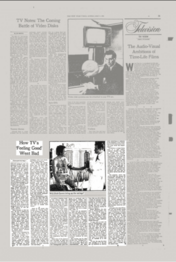
![An image of the newsletter[4].](/w/images/thumb/c/c3/Feelinggoodreport.png/262px-Feelinggoodreport.png)
